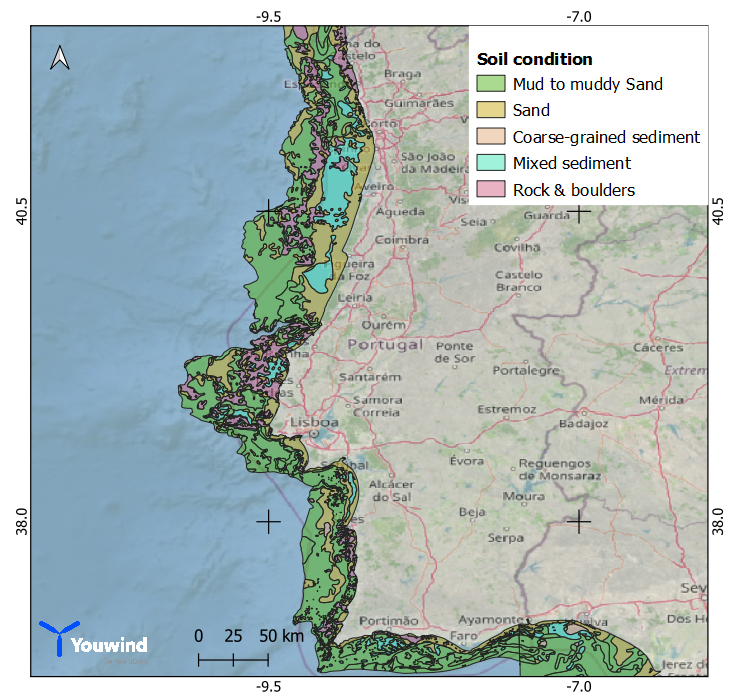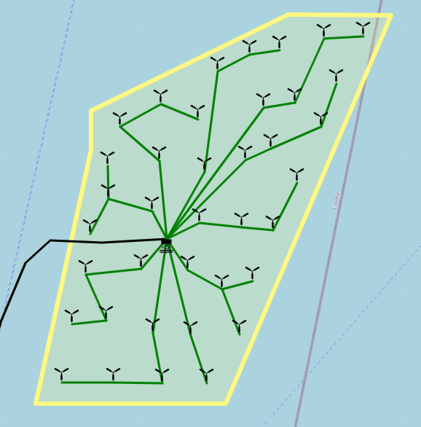In this article, we give an overview of the latest additions to the Youwind IT Platform:
- The possibility to take into account local soil conditions in foundation costing
- Calculation of Export cable availability based on the length of the cables
As always, you can write to info@youwindrenewables.com to get further information or help from our offshore wind experts.
Impact of soil conditions on foundation costing
Youwind is now updated with engineering functions that adjust the weight of monopiles or jackets to local soil conditions when analyzing potential locations for fixed-bottom offshore wind turbines.
The soil conditions that can be extracted directly in the Youwind platform are categorized as follows:
- Mud to muddy sand
- Sand
- Coarse-grained sediment
- Mixed sediment
- Rock & boulders
The available datasets that are part of this current update are the following:
- Europe (Source: EUSeaMap - Broad-scale Seabed Habitat Map for Europe)
- Australia (Source: Spatial Analysis of Biophysical Variables by Geoscience Australia)
- US Pacific (Coastal and Marine Ecological Classification Standard Version 4.0 - Federal Geographic Data Committee).
More datasets that cover the rest of the world will follow in the coming weeks.
As an example, the different types of soil conditions in Portugal can be seen in the figure below.

In the Area Screening part of the Youwind app, you can extract the soil condition on each potential wind park location (pixel). The condition will be shown below the map in the Area Screening Table:

Prior to this update the weight of fixed-bottom foundations was calculated based on turbine weight, tower and rotor diameter, and water depth (bathymetry). Now we have extended the calculations to apply a soil-condition-dependent scaling factor on the foundation weight.
The scaling factors are defined in the Foundation library items (https://app.youwindrenewables.com/foundations). After choosing either monopile or jackets the soil condition scaling factors are shown:

In the example above, the foundation's total weight does not increase in weight if the soil property for the given location is sand. The weight does however increase by 10% if the soil condition is a mixed sediment, and with 45% if the soil condition is Rock and boulders.
The scaling factor of the soil properties above is an estimated preset by Youwind but these values can be customized in each Youwind user library.
After selecting a development area, the foundation weight and cost are shown in more detail in the Scenario overview and finance in the Foundation assumptions and CAPEX tables.
Note that in the Scenario overview, you can choose whether Youwind performs the calculation using the checkbox Use soil condition. If you deselect it, the scaling factors will not be applied to the foundation weight calculation.
Automatic calculation of Export cable availability
When you need longer electricity export cables to connect your offshore wind park to the grid, the risk of failures due to damage to the cables increases. Therefore, when taking into account availability losses in wind parks, we can base it on the length of the cables. The Youwind app already automatically calculates the length of the cables and their efficiency based on its technical specifications. Now the app can automatically adjust the export cable availability to the calculated length of the cable.
The calculation is based on:
- A probability of failure in a year per kilometer cable, as you define in the Export cable library item (see below).
- The average repair time in days, also defined in the library item
- The number of offshore substations and their capacity in your wind park scenario. We take into account the fact that if your wind park has multiple export connections to shore, and only one connection fails, the wind park can still export part of its production. Similarly, we calculate the impact and probability of several connections failing when calculating the Export cable availability impact on AEP.
The default preset values of probability of failure per km, and the average repair time, are based on this Tennet position paper.

The resulting Export Cable Availability is listed with other Efficiency and availability percentages in the Scenario overview and combined to show the total impact on Net AEP.
Note that in the Scenario overview, you can choose whether Youwind performs the calculation using the checkbox Youwind calculates export cable availability (%). If you deselect it, it will use the fixed Fallback availability percentage defined in the Export Cable library item.
About Youwind Renewables
Youwind is the leading web-based engineering application for offshore wind.
The highly flexible application models the complete engineering and financial project lifecycle of your Offshore Wind projects and optimizes your workflow. Youwind is made by offshore wind experts for professionals in the field.
Its collaborative and integrative approach allows projects to be analyzed and executed more efficiently and reliably. Our solutions empower project developers, suppliers, and investors to make reliable decisions more efficiently without losing accuracy.
Try out all the Youwind functions on the Youwind IT Platform.




